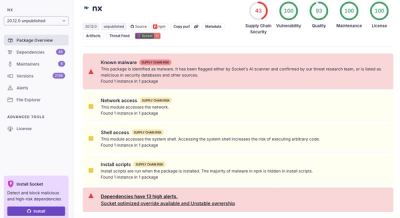
Security News
Risky Biz Podcast: Making Reachability Analysis Work in Real-World Codebases
This episode explores the hard problem of reachability analysis, from static analysis limits to handling dynamic languages and massive dependency trees.
Use a slider to convoke data-display functions with boundary parameters.
Load the panorama with data, and supply a display function that will be passed the canvas and the data.
Supply the display function when new data is added to the panorama.
Supply a function that tells dataslider how to add data together. The return value will overwrite the stored data.
Supply an event emitter and the type of event to listen for. When that type is fired, two things happen
The order of these is settable on invocation, but defaults to the above order. If addFn happens first, then old data in setDisplayFn will be the old + new data, and the newdata will simply be provided for reference.
Supply a function that will recieve a params s.t.
params : { pos : { left : 20, right:40 }, type : drag }
// type will either be a drag or resize.
Supply an image list with image objects, where each image object is the native Image object. Each image object should also have a .name property. The following will be used as a lookup table between image objects and how they will be used.
name: selector_left.png -> left selector
name: selector_right.png -> right selector
name: selector_left_hover.png -> left selector on hover
name: selector_right_hover.png -> right selector on hover
name: selector_left_down.png -> left selector on mousedown
name: selector_right_down.png -> right selector on mousedown
Since you need to setup these functions, here is some copy paste.
dataslider.to();
dataslider.onchange(function(params) { });
dataslider.setImages(images);
dataslider.load(,function(canvas,data) { });
dataslider.listen(,);
dataslider.setAddFn(function(old,newdata) {})
dataslider.setDisplayAddFn(function(canvas,old,newdata) { });
FAQs
view your data according to a slider
The npm package dataslider receives a total of 1 weekly downloads. As such, dataslider popularity was classified as not popular.
We found that dataslider demonstrated a not healthy version release cadence and project activity because the last version was released a year ago. It has 1 open source maintainer collaborating on the project.
Did you know?

Socket for GitHub automatically highlights issues in each pull request and monitors the health of all your open source dependencies. Discover the contents of your packages and block harmful activity before you install or update your dependencies.

Security News
This episode explores the hard problem of reachability analysis, from static analysis limits to handling dynamic languages and massive dependency trees.

Security News
/Research
Malicious Nx npm versions stole secrets and wallet info using AI CLI tools; Socket’s AI scanner detected the supply chain attack and flagged the malware.

Security News
CISA’s 2025 draft SBOM guidance adds new fields like hashes, licenses, and tool metadata to make software inventories more actionable.